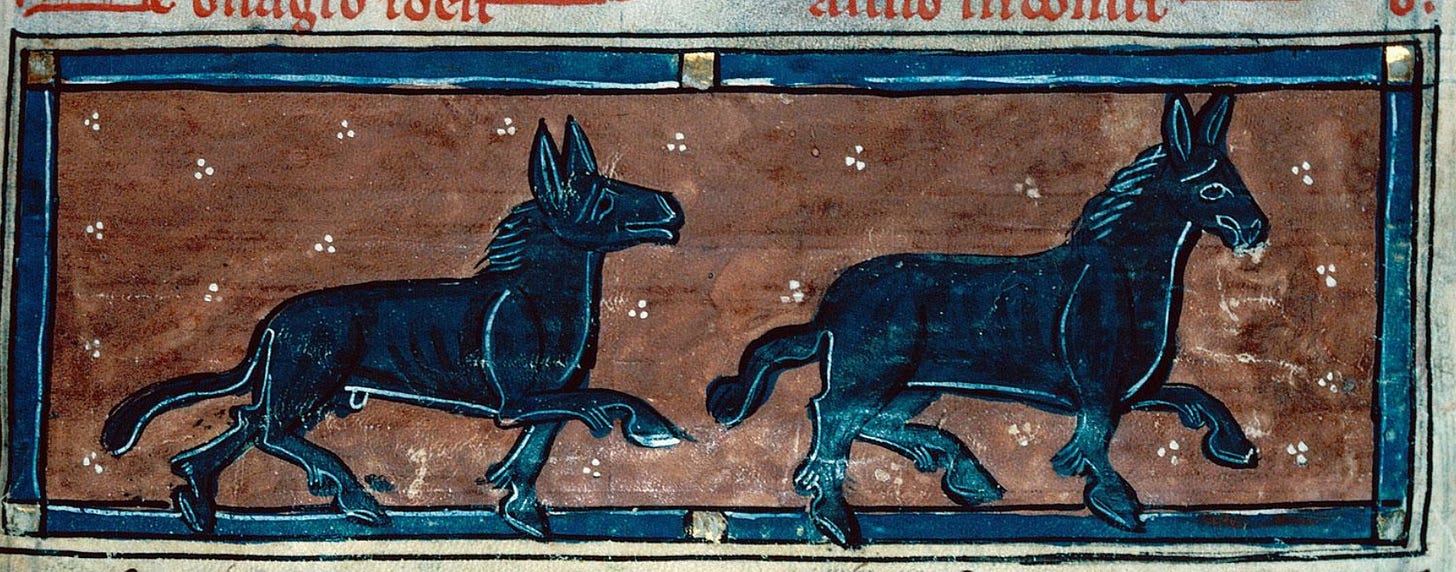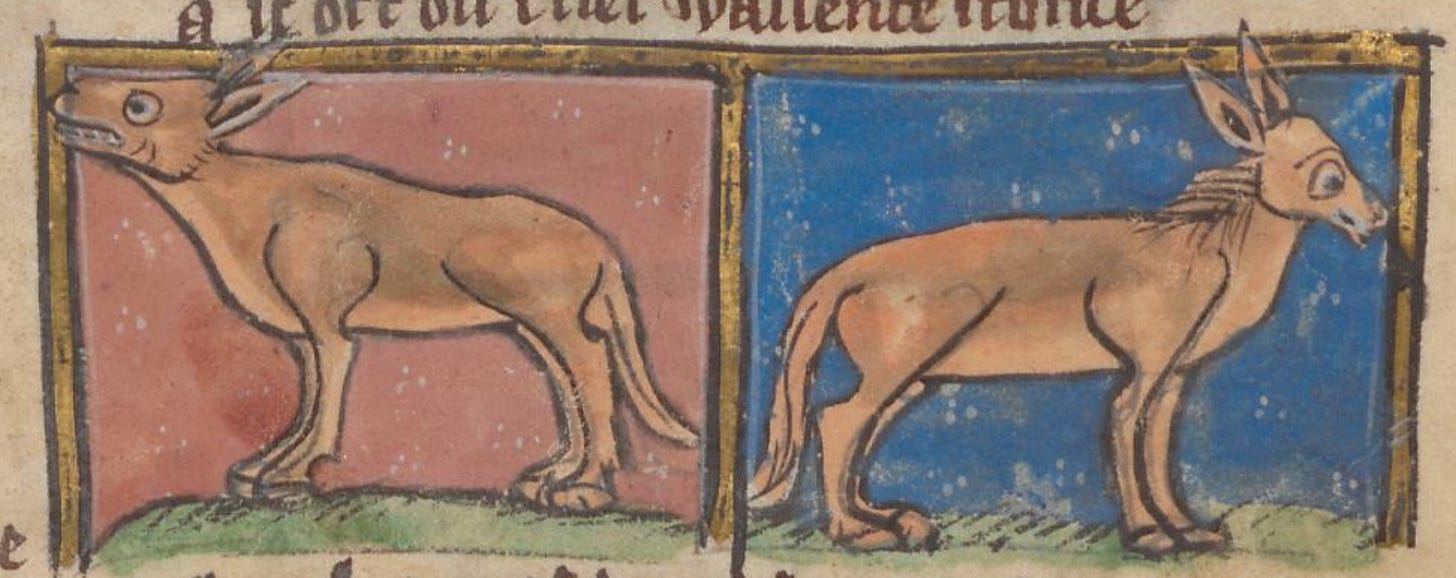The Ass & The Onager (Part 1)
Beast of Burden & Wild Ass
“That night God came to Balaam and said to him: If these men have come to summon you, go back with them; yet only on the condition that you do exactly as I tell you. So the next morning when Balaam arose, he saddled his donkey, and went off with the princes of Moab.
But now God’s anger flared up at him for going, and the angel of the Lord took up a position on the road as his adversary. As Balaam was riding along on his donkey, accompanied by two of his servants, the donkey saw the angel of the Lord standing in the road with sword drawn. The donkey off the road and went into the field, and Balaam beat the donkey to bring her back on the road. Then the angel of the Lord stood in a narrow lane between vineyards with a stone wall on each side. When the donkey saw the angel of the Lord there, she pressed against the wall; and since she squeezed Balaam’s leg against the wall, he beat her again.
Then the angel of the Lord again went ahead, and stood next in a passage so narrow that there was no room to move either to the right or to the left. When the donkey saw the angel of the Lord there, she lay down under Balaam. Balaam’s anger flared up and he beat the donkey with his stick.
The Lord opened the mouth of the donkey, and she asked Balaam, “What have I done to you that you beat me these three times?” “You have acted so willfully against me,” said Balaam to the donkey, “that if I only had a sword at hand, I would kill you here and now.” But the donkey said to Balaam, “Am I not your donkey, on which you have always ridden until now” Have I been in the habit of treating you this way before?” “No,” he replied.
Then the Lord opened Balaam’s eyes, so that he saw the angel of the Lord standing on the road with sword drawn; and he knelt and bowed down to the ground. But the angel of the Lord said to him: “Why have you beaten your donkey these three times? I have come as an adversary because this rash journey of yours is against my will. When the donkey saw me, she turned away from me these three times. If she had not turned away from me, you are the one I would have killed, though I would have spared her.”
- Balaam and the Ass (Numbers 22:20-33)
Since the time of Balaam, and perhaps before, the ass or donkey has been a symbol of humility and associated with miracles and faith. Like many animals in bestiaries, the symbolism of the donkey is polyvalent, encompassing both nobility and absurdity. In this series, I will explore the symbolism of the donkey or “ass” as found in Medieval bestiaries and ancient writers.
This first post will focus on the ass as a beast of burden and on the wild ass or “Onager.”
Section 1 - The Ass as Beast of Burden
On a practical level, donkeys were used as a beast of burden due to them being cheaper than horses but still very durable.
St. Isidore provides a definition of “beasts of burden” in his Etymologies:
“‘Beasts of burden’ (iumenta) derive their name from the fact that they assist (iuvare) our labor and burdens by their help in carrying or plowing, for the ox pulls the carriage and turns the hardest clods of earth with the plowshare; the horse and ass carry burdens, and ease people’s labor when they travel. Whence they are called beasts of burden because they assist humans, for these are animals of great strength.”
St. Isidore goes on:
“The ass (asinus) and the ‘small ass’ (asellus, dim. of asinus) are so called from ‘sitting’ (sedere), as if the word were asedus. The ass took this name, which is better suited to horses, because before people captured horses, they began by domesticating (praesidere, lit. “sit on”) the ass. Indeed, it is a slow animal and balks for no reason; it allowed itself to be domesticated as soon as mankind wished it.”
Pliny relates how the donkey is unable to endure the cold, so it must be bred in the summer (summer solstice). She-asses will seek the cover of darkness when about to give birth, so as to avoid the observation of man. They live for thirty years and are capable of breeding throughout their entire lives.
Pliny goes on: “Their attachment to their young is great in the extreme, but their aversion to water is still greater. They will pass through fire to get at their foals, while the very same animal, if the smallest stream intervenes, will tremble, and not dare so much as to wet even its feet.” They are resistant to drink from unknown watering places and will not cross a bridge if they can see the water beneath the planks.
Section 2 - The Symbolism of the Onager (Wild Ass)
Bestiaries often distinguished between the domesticated ass, which was gentle and docile, and the fierce, untamable wild ass or onager. St. Isidore wrote that, “Africa possesses large untamed onagers wandering through the desert. Individual onagers lead herds of females. When male colts are born, the adult males become jealous and bite off their testicles, so that the wary mothers hide the male colts in concealed places.”
It was thought that the male onagers were so consumed with lust that they would castrate young colts so they would not have to share the females.

The Book of Job (39:5-8) mentions the onager in relation to God’s sovereignty over creation:
“Who has given the wild donkey his freedom, and who has loosed the wild ass from his bonds? I have made the wilderness his home and the salt flats his dwelling. He scoffs at the uproar of the city, hears no shouts of a driver. He ranges the mountains for pasture, and seeks out every patch of green.”
According to The Grand Medieval Bestiary, male onagers are a symbol of the two modes of generations for the Chosen People. Male onagers represent the Old Testament patriarchs, who procreated through the flesh and castrated males stood for Christians who procreate spiritually, through conversion.
It was also thought that the onager brays night and day and the number of brays marks the hour. On March 25, the onager brays twelve times to signal the spring equinox, which is also the Feast of the Annunciation.
The Physiologus states:
“The wild ass represents the devil since, when he
knows that night and day are equal (that is, when the
devil perceives that those walking in the shade and
shadow of death have turned lately to the living Lord
and equal the faith of the patriarchs and prophets as
night equals day), then he brays day and night, hour by
hour, seeking the food which he has lost. Now the wild
ass brays only when receiving food, as Job said, "Never
without cause does the wild ass bray but only when
wanting fodder" [cf. Job 6: 5].”
There is another aspect of the symbolism of the onager as the devil. Like many large mammals, the onager commands a harem of females. He keeps them under control by castrating the male colts as they are born. Like the Old Testament figure of Moses, who was protected as a baby by his mother from the Pharaoh, female onagers hide their male children so they are not harmed by the chief male. In the New Testament, the Holy Family ironically flees to Egypt to escape Herod as he massacres all male children under two years of age to protect his own authority.

In the next post, I will discuss both the positive and negative symbolic associations with the donkey.
All Medieval manuscript images were obtained from https://bestiary.ca/index.html




